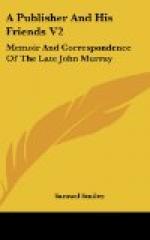Mr. Murray had considerable intercourse with the publishers of Edinburgh, among the chief of whom were Messrs. Creech & Elliot, and by their influence he soon established a connection with the professors of Edinburgh University. Creech, who succeeded Mr. Kincaid in his business in 1773, occupied a shop in the Luckenbooths, facing down the High Street, and commanding a prospect of Aberlady Bay and the north coast of Haddingtonshire. Being situated near the Parliament House—the centre of literary and antiquarian loungers, as well as lawyers—Creech’s place of business was much frequented by the gossipers, and was known as Creech’s Levee. Creech himself, dressed in black-silk breeches, with powdered hair and full of humorous talk, was one of the most conspicuous members of the group. He was also an author, though this was the least of his merits. He was an appreciative patron of literature, and gave large sums for the best books of the day.
Mr. Elliot, whose place of business was in the Parliament Close, and whose daughter subsequently married Mr. Murray’s son the subject of this biography, was a publisher of medical and surgical works, and Mr. Murray was his agent for the sale of these in London. We find from Mr. Elliot’s letters that he was accustomed to send his parcels of books to London by the Leith fleet, accompanied by an armed convoy. In June 1780 he wrote: “As the fleet sails this evening, and the schooner carries 20 guns, I hope the parcel will be in London in four or five days”; and shortly afterwards: “I am sending you four parcels of books by the Carran, which mounts 22 guns, and sails with the Glasgow of 20 guns.” The reason of the Edinburgh books being conveyed to London guarded by armed ships, was that war was then raging, and that Spain, France, and Holland were united against England. The American Colonies had also rebelled, and Paul Jones, holding their commission, was hovering along the East Coast with three small ships of war and an armed brigantine. It was therefore necessary to protect the goods passing between Leith and London by armed convoys. Sometimes the vessels on their return were quarantined for a time in Inverkeithing Bay.
The first Mrs. Murray died, leaving her husband childless, and he married again. By his second wife he had three sons and two daughters, two of the sons, born in 1779 and 1781 respectively, died in infancy, while the third, John, born in 1778, is the subject of this Memoir. In 1782 he writes to his friend the Rev. John Whitaker: “We have one son and daughter, the son above four years, and the daughter above two years, both healthy and good-natured.”
In June 1782 Mr. Murray had a paralytic stroke, by which he, for a time, lost the use of his left side, and though he shortly recovered, and continued his work as before, he was aware of his dangerous position. To a friend going to Madeira in September 1791 he wrote: “Whether we shall ever meet again is a matter not easily determined. The stroke by which I suffered in 1782 is only suspended; it will be repeated, and I must fall in the contest.”




